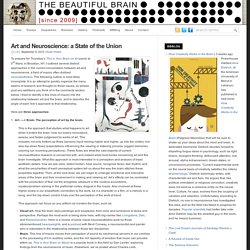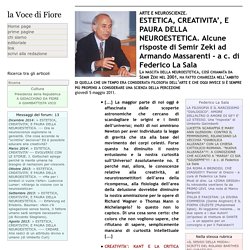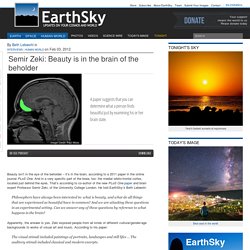

Neuroscienziati. Association of Neuroesthetics - MISSION. Art and Neuroscience: a State of the Union. To prepare for Thursday’s This is Your Brain on Art panel at 3rd Ward, in Brooklyn, NY, I outlined several distinct approaches in the current conversation between art and neuroscience, a field of inquiry often dubbed neuroaesthetics.

The following outline is most likely incomplete. It is an attempt to quickly organize the many strains of research and thought on these issues, so please post any additions you think of in the comments section below. I tried to identify a few lines of inquiry into the relationship between art and the brain, and to describe the angle of each line’s approach to that relationship.
Here are three approaches: 1. This is the approach that studies what happens to art when it enters the brain: how our brains reconstruct, assess, and fasten judgement to works of art. This approach can focus on any artform as it enters the brain, such as: Visual art. 2. Some further thoughts on these parallels, specific to film. 3. ESTETICA, CREATIVITA', E PAURA DELLA NEUROESTETICA. Alcune risposte di Semir Zeki ad Armando Massarenti - a c. di Federico La Sala. Giulio Tononi Neuroscienziato Intervista “Con la formula Phi prendo le misure all’Io” Da una serie di test nasce la “teoria dell’informazione integrata” “Il prossimo passo è mappare tutte le connessioni cerebrali” I COLLEGHI AMERICANI «Questa è l’unica ipotesi promettente su cos’è la coscienza» di Silvio Ferraresi (La Stampa/TuttoScienze, 15.06.2011) Solo 20 anni fa la coscienza era considerata una materia impalpabile ed effimera, inconcepibile come oggetto della scienza.

Professore, come nasce la sua teoria? «Dall’esperimento mentale del fotodiodo - il sensore che si attiva o si disattiva in presenza di luce e di buio -: l’ho concepito quando ancora studiavo medicina». In che cosa consiste il test? «Immaginiamo di condividere una stanza buia con il fotodiodo. Che cos’è l’informazione integrata? «Cominciamo definendo l’informazione. E’ qui che entra in scena l’integrazione? «Possiamo spiegarla con l’esempio della fotocamera digitale. Che cosa indica Phi? «Non necessariamente. Zeki, Semir, La visione dall’interno, arte e cervello. Estetica, Psicologia (neuroscienze) Indice - L'autore - Links La visione dall’interno è una sorta di fondazione della neuroestetica.

Semir Zeki, professore di Neurobiologia allo University College di Londra, si è occupato per circa trent’anni dello studio della corteccia visiva e ha annodato quest’approccio alla visione e all’immagine tanto a un passione per l’arte quanto a un’esplorazione delle estetiche classiche, di matrice essenzialmente, anche se non esclusivamente, platonica e hegeliana. L’assunto di fondo è che, poiché l’estetica presuppone una conoscenza minuta e complessa della visione, e giacché una conoscenza del genere non può essere raggiunta in assenza di un discorso neuroscientifico, allora un’estetica che abbia pretesa duratura di validità dovrebbe essere biologicamente fondata.
Prof Zeki's Musings. Semir Zeki: Beauty is in the brain of the beholder. Beauty isn’t in the eye of the beholder – it’s in the brain, according to a 2011 paper in the online journal PLoS One.

And in a very specific part of the braia, too: the medial orbito-frontal cortex, located just behind the eyes. That’s according to co-author of the new PLoS One paper and brain expert Professor Semir Zeki, of the University College London. He told EarthSky’s Beth Lebwohl: Philosophers have always been interested in: what is beauty, and what do all things that are experienced as beautiful have in common? And we are attacking these questions in an experimental setting. Apparently, the answer is yes. The visual stimuli included paintings of portraits, landscapes and still lifes … The auditory stimuli included classical and modern excerpts. Zeki found, by examining MRI images of his subjects’ brains, that when people look at something they find beautiful, a portion in the front part of the brain called the medial orbito-frontal cortex “lights up.”